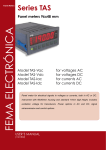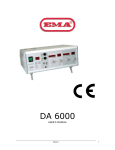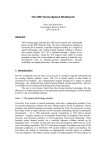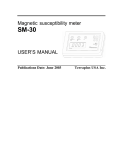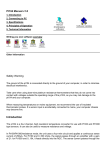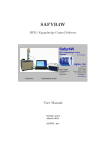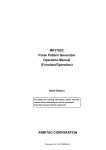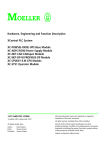Download FEMA ELECTRÓNICA
Transcript
Datasheet FEMA ELECTRÓNICA INTELLIGENT PANEL METERS Series Intelligent Panel Meters TAS-1-IAC TAS-1-IDC TAS-1-VAC TAS-1-VDC AC DC AC DC Current Current Voltages Voltages USER’S MANUAL Amplicon.com IT and Instrumentation for industry Sales: +44 (0) 1273 570 220 Website: www.amplicon.com Email: [email protected] Datasheet 1.1-INDEX 1.- Introduction 1.1.- Index 1.2.- If this is the first time you work with a TAS-1 meter 1.3.- Frontal View and Rear View of the instrument 2 3 3 2.- Quick Reference Guide 2.1.- Connections 2.2.- Programming Menu 4 4 3.- Configuration 3.1.- Input Signal 3.2.- Direct Access 3.2.1- Decimal Point Position 3.2.2- Adjusting the Low Indication 3.2.3- Adjusting the High Indication 3.2.4- Alarm Setpoints 3.2.5- Correcting a Low Input Signal 3.2.6- Correcting a High Input Signal 5 5 5 5 5 5 4.- Advanced Configuration 4.1.- Input Signal for : DC Voltage 4.2.- Input Signal for : AC Voltage 4.3.- Input Signal for : DC Current 4.4.- Input Signal for : AC Current 4.5.- Alarm Configuration 4.6.- Manual Adjustment 4.7.- Dealing with Errors 4.8.- Advanced Indication 4.9.- Blocking the Keypad 4.10.- Resetting the system. Default values 4.11.- Messages and Errors 6 6 6 6 6 7 7 7 7 7 8 5.- Configuring with a PC 8 6.- Technical Specifications and Dimensions 9 7.- Available Options .- Installing and Configuring 7.1- Analog Output - TSAT Option Board 7.1.1- Connections 7.1.2- Technical Characteristics 7.1.3- Start-Up 7.1.4- Configuration 7.2- Installing the option boards 7.3- Modbus Output - R485M Option Board 7.3.1- Configuration 7.3.2- Accepted Functions 7.3.3- Register Map 7.3.4- Connections and Bus Terminator 7.3.5- Modbus frame structure-I 7.3.6- Character Structure 7.3.7- Modbus frame structure-II 7.4- Peak, Valley, Hold, Tare, Reset - TEK Option Board 7.4.1- Available Functions 7.4.2- Connections 7.4.3- Configuration 10 10 10 10 10 11 11 12 12 12 12 13 13 13 13 14 14 14 14 8.- CE Certificate / Warranty 9.- Safety Information 15 15 Amplicon.com IT and Instrumentation for industry Sales: +44 (0) 1273 570 220 Website: www.amplicon.com Email: [email protected] 5 Datasheet 1.2- IF THIS IS THE FIRST TIME YOU WORK WITH A TAS-1 METER... We strongly recommend you to read the following paragraphs. Following ideas need to be clearly understood in order to easily adjust and program the unit. WHEN POWERING THE INSTRUMENT the meter displays a message indicating the configured signal input range (see page 4). IF THE TAS-1 DETECTS A STRANGE SITUATION on the instrument status, or sensor break, etc, the instrument will show an error message (see page 8 «messages and errors»). THE FRONTAL KEYPAD is composed of 5 function/key pads and 1 programming pad. The pads have two functions, acting both as number keys (when a number needs to be entered) and as direct access keys to the following functions : Key AL Key HI Key LO Key ADJ - Key DP - Access to the ALARM setpoints Value for the HIGH Indication Value for the LOWIndication Access to the automatic «on the field» offset correction and High Level Input Signal correction Decimal Point Position Key PROG - Allows the introduction of the PROGRAMMING codes (4 digit codes, as shown on page 4). These codes, when validated, activate different input signal modes, and advanced configurations for alarms, indication, etc. «TIME» MESSAGE .- If while introducing a programming code or while reconfiguring the unit parameters (such as the alarm setpoints or others) the user does not interact with the unit for a period of 5 seconds, the TAS-1 will show the message «TIME», cancel the ongoing changes, and roll-back to the previous configuration. This is a security function which disables the situation where a unit would be «hanged» for a long time waiting for the operator to finish a programming. THE TAS-1 UNITS ARE FULLY CONFIGURABLE. The unit is 100% configurable from the frontal keypad. The programming software also allows an easy configuration from a PC (PCConnection Cable needed). OPTIONS .- This manual includes description and operating instructions for the basic unit and the additional extra options accepted. These options include Relay Output Contacts, Analog Outputs, RS485 Outputs, Peak/Valley memory, etc. If your instrument does not include these options, they can easily be added. SIGNAL INPUT RANGES .- To work with an input signal range not indicated in this manual, select the closest input signal range accepted, and change the input/indication parameters with the code 14 11 (see later in this manual). For example, to configure a 0/60 mV input coming from a 10 Amper shunt, we need to : 1.- select the 0/100 mV input signal range 2.- enter on code 14 11 for Editing Adjustments 3.- edit 0=0 and 60=10.000 If later on we need to change the 10.000 value for any other value we can do it directly with the keypad HI. 1.3- FRONTAL VIEW AND REAR VIEW TAS-1 Frontal View Indication 5 displays 7 segments TAS-1 Rear View Activity Led Units Status Led for alarms 1,2,3 and 4 Relay 2 Output Relay 1 Output Output for Optional Boards (See pages 10 to 14) Input Signal (3 or 4 pole Terminal depending on the unit) Decimal Point Leypad Function Led Red Led - keypad acting as number Green Led - keypad acting as direct access 6 pads for programming double function Power Connector for PC Configuration (PCConnector cable needed) (N) (+) (L) (-) Note .- The 2 relay outputs and the Optional Boards are OPTIONAL and are NOT INCLUDED with the basic unit. Amplicon.com IT and Instrumentation for industry Sales: +44 (0) 1273 570 220 Website: www.amplicon.com Email: [email protected] Datasheet 2.1- CONNECTIONS Relay 2 - + - TAS-1-VAC 0/650 Vdc 0/100 Vdc 0/10 Vdc 0/650 Vac 0/100 Vac 0/1 Vdc 0/100 mVdc 0/20 mVdc 0/1 Vac 0/100 mVac COMON NC NO NO NC COMON + TAS-1-VDC Relay 1 Relay Outputs Input Signal + - TAS-1-IDC TAS-1-IAC 0/5 0/5 Adc Aac Power Connector for PC Configuration (PCConnector cable needed) + 0/100 mAdc 0/100 mAac Phase (-) Earth Neutrum (+) 2.2- PROGRAMMING MENU DC -V S-1 TA S TA -1 -ID C C -IA S-1 TA AC -V S-1 TA 11 XX g e itin s t m Ed d j u A 14 11 XX nt 11 s m ar Al 13 11 1 m ar Al 13 12 2 m ar Al 13 13 3 m ar Al 13 14 ↵ 11 35 0/5Adc 11 41 0/5Aac 11 33 0/100mAdc 11 34 0/100mAac EDIT IN LO XXXXX 11 XX AL 1 ACTIU OFF ↵ 11 24 0/650Vdc 11 32 650Vac 11 23 0/100Vdc 11 31 100Vac 11 22 0/10Vdc 11 11 0/1Vdc 11 14 1Vac 11 12 0/100mVdc 11 15 11 13 100mVac 0/20mVdc 1 1 13 15 TIPE AL HI 1 ↵ IN HI XXXXX ALSET HIST RIGHT ↵ ↵ INPUT ↵ al iza 1 2 3 OFF ON 1 ON OFF FIL 1 1 DIR Alarm Setpoints Correcting the LOW input signal Correcting the HIGH input signal Adjusting the LOW Indication TEXT ON INPUT 1 1 ONERR ON OFF 1 1 ↵ 1 2 3 INPUT ADQN 1 1 STEP XXXXX INPUT 1 STRING XXXX ↵ INPUT Amplicon.com ↵ INPUT ↵ Adjusting the HIGH Indication Decimal Point Position ↵ 1 1 ↵ 1 OFF ↵ DEF CONFR 1 ↵ ult 22 ↵ ↵ INV 14 fa * IMPORTANT: Before validating a PASSWORD with the Keypad Blocking menu, remember the 5 digit number you are about to enter. The instrument will not accept any future order until the same 5 digit password is reintroduced. IT and Instrumentation for industry Sales: +44 (0) 1273 570 220 Website: www.amplicon.com Email: [email protected] Referencia Rápida Configuration : Direct Access * ↵ PASSWORD XXXX FILT REAL LED 14 15 ↵ ↵ AVERA INPUT 14 De nd r s t a ete e s Re r a m Pa ↵ ↵ DL1 XXXXX ↵ 14 ↵ FIL 3 ↵ DI HI XXXXX t ad * en or m yp ing Err eat Ke ck o l Tr B LAST FIL 2 Input Signal Ranges ti 13 1 ON HIST XXXXX su DISPLAY NULL SMODE OFF AL-1 XXXXX Vi on ↵ LEFT 1 AL LO SM 14 CENTR ↵ DI LO XXXX ↵ a s: m sis ar re Al yste H ↵ ON 11 XX 4 nd Datasheet 3- CONFIGURATION Section 3.1 shows how to enter a code to select an input signal range. All codes are indicated on page 4. 3.1- INPUT SIGNAL The TAS-1 units have several built-in predefined input signal ranges, selectable with the help of codes (4 digit codes). On page 4 there is a list of all accessible ranges and the codes associated. Examples in this page show how to configure a TAS-1-IAC unit with an input signal of 0/5 Aac and indication 0/2500.0. All other units and signal ranges follow the same procedures. CONFIGURING A 0/5 AAC INPUT SIGNAL RANGE (Code 11 41 ; as shown on table on page 4, for a TAS-1-AAC unit) 1- Press Prog message «Prog» during 1 second blank screen V 3.2- DIRECT ACCESS 2- Input the code 11 41 R The frontal keypad hasseveral direct access buttons for a quick configuration of the instrument : 3- Validate the code pressing ↵ R Pad 1 (ADJ) Pad 2 (DP) Pad 3 (LO) Pad 4 (HI) Pad 5 (AL) - Correct the LOW or HIGH input levels Decimal Point Position Set for the LOW indication level Set for the HIGH indication level Alarms Setpoint V 3.2.4- ALARM SETPOINTS Fix the setpoint for Alarm1 at 10500 1-Press 3.2.1- DECIMAL POINT POSITION Activate the Decimal Point at position XXXX.X AL 2-Enter the number of the alarm we want to modify 1 V 1- Press 4- Message showing the selected range «5 A» during 1 second V V DP 2- message «DP» during 1 second Press 2 to fix decimal point position 2 (To fix at other positions, press 1,2,3,4 or 5) ↵ 3- Validate changes pressinf 3-Current value for Alarm1 setpoint is displayed. Modify it by pressing on 1,2,3,4,5 until we see 10500 R 4-Validate the changes pressing ↵ R R R message «INPUT» shows the configuration has been accepted message «INPUT» shows the configuration has been accepted 3.2.2-ADJUSTING THE LOW INDICATION VALUE For the low input level (0 Aac) we want to V configure a low indication of 0000.0 1-Press Lo 3.2.5-CORRECTING THE LOW INPUT SIGNAL (OFFSEET) Allows offset correction, by linking the current input signal on terminals to the Low Indication Value memorized. 2- Current value for the low indication is displayed. Modify it by pressing on 1,2,3,4,5 until we see 00000 2-Press Adjust Adj The instrument asks «Hi» or «Lo» ? 1-Generate the low input level signal V 3-Validate the changes pressing R V R 3-Press ↵ 4-Message «Cr Lo» shows the unit has corrected the low level value, linking the current input signal value to the low indication value memorized (LO keypad) message «INPUT» shows the configuration has been accepted 3.2.3- ADJUSTING THE HIGH INDICATION VALUE For the high input level (5 Aac) we want to configure a high indication of 2500.0 V 1-Press Hi 2- Current value for the high indication is displayed. Modify it by pressing on 1,2,3,4,5 until we see 25000 3-Validate the changes pressing ↵ message «INPUT» shows the configuration has been accepted Amplicon.com Lo 3.2.6-CORRECTING THE HIGH INPUT SIGNAL Allows to link a current signal at the input terminals to the High Indication Value memorized on the HI keypad. 1-Generate the high input level signal V R R 2-Press Adjust Adj The instrument asks «Hi» or «Lo» ? 3-Press V Hi V 4-Message «Cr Hi» shows the unit has corrected the high level value, linking the current input signal to the high indication value memorized (HI keypad) IT and Instrumentation for industry Sales: +44 (0) 1273 570 220 Website: www.amplicon.com Email: [email protected] Datasheet 4-ADVANCED CONFIGURATION 4.1- INPUT SIGNAL : DC VOLTAGE 4.2- INPUT SIGNAL : AC VOLTAGE Codes : 11 XX Input Code 0/650 Vdc 11 0/100 Vdc 11 0/10 Vdc 11 22 0/1 Vdc 11 0/100 mVdc 0/20 mVdc Codes : 11 XX Message Input Code 24 0/650 Vac 11 32 23 0/100 Vac 11 31 11 0/1 Vac 11 14 11 12 0/100 mVac 11 15 11 13 4.3- INPUT SIGNAL : DC CURRENT 4.4- INPUT SIGNAL : AC CURRENT Codes : 11 XX Input Code 0/5 Adc 11 0/100 mAdc 11 Message Codes : 11 XX Input Code 35 0/5 Aac 11 41 33 0/100 mAac 11 34 Message Message 4.5- ALARM CONFIGURATION Alarm Number CODE Menu Alarm 1 Alarm 2 Alarm 3 13 13 13 11 12 13 Alarm Parameters Alarm Parameters Alarm Parameters Alarm 4 General 13 13 14 15 Alarm Parameters Hysteresis and SM The alarm configuration menu list several parameters to which we must assign a value. Numerical values are assigned with the number pads. Predefined values (such as ON/OFF) are selected by selecting available options with keys ‘1’, ‘2’ or ‘3’. Validate with key ’↵ ↵ ’ in order to access next parameter. Menu : Alarm Parameters Parameters Values Description Alarm1 working Alarm1 not working Alarm1 working as «maximum» Alarm1 working as «minimum» Setpoint for Alarm1 (expressed in display points) Hysteresis value (max. 255) (expressed in display points) Delay on relay activation (expressed in seconds) Led is active when alarm is active Led is active when alarm is inactive Alarm text active Alarm text inactive Menu : Hysteres and SM Parameters configured on this menu apply to the 4 alarms Parameters Values Function Hysteresis is applied to the process of alarm deactivation* Band alarm. Hysteresis is applied to the process of alarm activation and deactivation* Hysteresis is applied to the process of alarm activation.* *The hysteresis points are defined on parameter HYST for each alarm. Security Mode activated on alarms acting as «minimum»** Securty Mode deactivated **Output relay are inactive until the set point is reached for the first time. Text associated with alarm led Amplicon.com IT and Instrumentation for industry Sales: +44 (0) 1273 570 220 Website: www.amplicon.com Email: [email protected] Datasheet 4.6- MANUAL ADJUSTMENT Code : 14 11 Parameters 4.8-ADVANCED CONFIGURATION Function : Code : 14 13 Values number number number number Function Input Low Display Low Input High Display High- Parameters Values Low Input Signal Indication for Low Signal High Input signal Indication for High Signal Fixes the least significant digit to zero Frees the least significant digit Fast filter on the input signal : 0.25 Seg 98% Medium filter on the input signal : 0.5 Seg 98% Slow filter on the input signal: 1 Seg. 98% 4.7- DEALING WITH ERRORS Parameters Function No zeros active to the left Zeros active to the left Code 14 11 can be used both to modify adjustments and to visualize current values. Code : 14 14 Function : Real time indication Indication of mean values Function : Values Time (between 1 and 255 seconds) to calculate mean values for mean indication Function Activates all alarms in case of error state * Deactivates all alarms in case of error state* 4.9- BLOCKING THE KEYPAD Code : 14 15 Parameters Function : Values Function * More information on «what is an error», on section 4.7 «Messages and errors» Blocks the frontal keypad Password is made of a numerical value of 5 digits 4.10-RESETTING THE SYSTEM. DEFAULT VALUES Code : 14 22 Function : Resets the unit to the default manufacturing values. It is needed to reconfirm the action by pressing INTRO after the message General Default Configuration Acquisition Mode Real STEP Value Zero Blanking 10 ON Least Significant Digit to zero Display Refresh OFF Filter 2 (0.5 seg.) Password deactivated Alarm Alarm Alarm Alarm 1 2 3 4 Setpoint Histeresis Delay Type Led Text String ON ON ON ON 1000 1000 1000 1000 0 0 0 0 HI HI HI HI DIR DIR DIR DIR OFF OFF OFF OFF 1 1 1 1 Hysteresis Security Mode OnError CENTER ON OFF Configuration TAS-1-IDC Default Configuration TAS-1-VDC Input Signal Lo - Low Level Indication 0/100 VDC 0 Input Signal Lo - Low Level Indication 0/5 ADC 0 HI - High Level Indication Decimal Point 100.00 0 0 0.0 0 HI - High Level Indication Decimal Point 5.000 0 0.0 0 0 Default Configuration TAS-1-VAC Input Signal Lo - Low Level Indication 0/650 VAC 0 HI - High Level Indication Decimal Point 650.0 0 0 0.0 0 Amplicon.com Configuration TAS-1-IAC Input Signal 0/5 AAC Lo - Low Level Indication HI - High Level Indication 0 5.000 Decimal Point 0 0.0 0 0 IT and Instrumentation for industry Sales: +44 (0) 1273 570 220 Website: www.amplicon.com Email: [email protected] AL-1 AL-2 AL-3 AL-4 Datasheet 4.11-MESSAGES AND ERRORS Messages and errors are active when the instrument senses a «not normal» situation . The instrument identifies the type of «anormality» and informs with an error or with a message. Errors «Errors» are associated with critical situtations which disable the hability to measure the signal. The «error» remains active on display until the situation disapears. At this time, the instrument recovers normal functionality. Messages «Messages» are associated with non-critical situations, those which only affect the measure temporary. The «message» remains active on display until the situation clears. The instrument recovers the normal working state when situation clears. The input signal is lower than selected range The input signal is higher than selected range Security waiting time exceeded while in configuration mode. The instrument rolls-back to the previous configuration Error when entering a data. Value not accepted. Reintroduce the value. (Typical case : The value assigned to hysteresis is higher than 255) «Errors» execute actions on alarms, activating or deactivating them depending on the status of variable OnErr (see page.11). Alarms recover their normal behaviour when the the error state clears. Internal Error. Restart the instrument. ** It is possible that no action is performed on alarms if this error is affecting the internal EPROM Mathematical Error 0 Parameters introduced for the input signal are not coherent. (Typical case : the high level value is similar or very close to low level value, on input signal range or indication) Mathematical Error 1: mathematical overflow. The unit is trying to process values higher than 32000 or lower than -32000. Error on Display Indication Trying to display a value higher than 32000 or lower than -19999. Reduce HI and LO levels dividing by 10. 5- CONFIGURING WITH A PC TAS-1 units allow configuration from a PC. You need software SW-TAS1 and the cable PCConnector. Cable is connected to the rear side of the instrument (stereo jack) and to the 9-pin SUB-D PC Port. Software installs executable file TAS-1.exe To force a writing onto the device press WRITE_D. Some changes already force a writing (such as changing the input signal), and ask for a confirmation. To force a configuration reading of the instrument press READ_D 1.- Select com port. Press «START COMM» 2.- Configuration windows open These windows contain all information on the unit. Meter and alarms are shown on the main window. Additional options are shown in the small window to the right. To save/load configurations on your hard disk, use buttons SAVE_F / READ_F. Note that the options (right windows) have their own configuration file independent of the main instrument and so have their own «SAVE TO FILE» / «LOAD FROM FILE» buttons. COM Selection «START COM» Button Options Configuration Window Signal/Display adjustments Input Signal Ranges «WRITE_D» Button Forces writing configuration to the instrument Amplicon.com IT and Instrumentation for industry Sales: +44 (0) 1273 570 220 Website: www.amplicon.com Email: [email protected] Datasheet 6- TECHNICAL SPECIFICATIONS INDICATION Display Digit Height Filter Indication Refresh ENVIRONMENTAL DATA 5 Digits, 7 Segments , Red Led High Brightness 14,2 mm. / 0,56’’ Anti-reflexive. From - 19999 to 32000 5 /seg. (Filter selectable) Working Temperature Storage Temperature Humidity MECAHNICAL DATA Dimensions A/D CONVERTER Speed Accuracy CMRR 14 Readings / Second 16 BIT + sign (± 65.000 points) > 130 dB Front Weight Standard 1/8 DIN 96 x 48 x 124 mm. (3,78" x 1.89" x 4,88") Protection IP65 (NEMA 4) 0,5 Kgs ALARMS AND RELAYS (OPTION AL2) POWER Standard Optional Optional 0 ... + 50 ºC -20 ... + 85 ºC 0 ... 85%, non condensaded 4 alarms on display. Alarms 1 and 2 can control Relays 1 y 2 (Option AL2) 2 Relays ON/OFF 2 A. (non inductive), 250 Vac Note .- AL2 option not mounted on standard units 230 Vac 50/60 Hz. Consumption 3,5W Max 115 Vac 50/60Hz. Consumption 3.8W Max 24 Vdc (±10%) isolated. Consumption 4W Max Isolation 1000 Vdc (Primary - Secondary) Maximum consumption at 24 Vdc .- 265 mA Peak current at start-up <600mA ANALÓG OUTPUT RS485 MODBUS OUTPUT PEAK / VALLEY, ETC OPTION UNIT TAS-1-VDC Input Signal Ranges Technical data see page 10 Technical data see page 12 Technical data see page 14 UNIT TAS-1-IDC 0/650 Vdc, 0/100 Vdc, 0/10 Vdc 0/1Vdc, 0/100 mVdc, 0/20 mVdc Input Signal Ranges 0/5 Adc 0/100 mAdc Note .- Although not mentioned above, the unit accepts any signal range between 0/20mV and 0/650Vdc, including 60mV, 100mV y150mV shunt signals. For these ranges. select the closest range and readjust with code 14 11 Note .- Although not mentioned above, the unit accepts any signal range between 0/100mA and 0/5 Adc. For these ranges. select the closest range and readjust with code 14 11 Accuracy Thermal Drift Input impedance Accuracy Thermal Drift Input impedance Effective Resolution 0,1% from reading ± 1 point ± 100 ppm/ºC 1 MOhm for Vin>1Vdc 5 MOhm for Vin<1Vdc 32.000 points Effective Resolution UNIT TAS-1-VAC Input Signal Ranges 0,1% of reading ± 1 point ± 150 ppm/ºC 0.02 Ohm for I>100mA 1 Ohm for I<100mA 32.000 points UNIT TAS-1-IAC 0/650 Vac, 0/100 Vac 0/1 Vac, 0/100 mVac Input Signal Ranges 0/5 Aac 0/100 mAac Note .- Although not mentioned above, the unit accepts any signal range between 0/20mVac and 0/650Vac, including 60mV, 100mV y150mV shunt signals. For these ranges. select the closest range and readjust with code 14 11 Note .- Although not mentioned above, the unit accepts any signal range between 0/100mAac and 0/5 Aac, including X/5 and X/1 Current Transformer signals. For these ranges. select the closest range and readjust with code 14 11 Accuracy Thermal Drift Input impedance Accuracy Thermal Drift Input impedance Effective Resolution 0,3% of reading ± 1 point ± 150 ppm/ºC 1 MOhm for Vin>1Vdc 5 MOhm for Vin<1Vdc 32.000 points Effective Resolution 0,3% of reading ± 1 point ± 200 ppm/ºC 0.02 Ohm for I>100mA 1 Ohm for I<100mA 32.000 points SIZES AND PANEL CUT-OUT 124mm 48mm 2mm 15mm 96mm Amplicon.com IT and Instrumentation for industry Sales: +44 (0) 1273 570 220 Website: www.amplicon.com Email: [email protected] 1234567890123456789 1234567890123456789 123456789012345678 9 92mm 123456789012345678 9 123456789012345678 9 123456789012345678 9 123456789012345678 9 123456789012345678 9 44mm 123456789012345678 9 123456789012345678 9 1234567890123456789 1234567890123456789 Datasheet 7- AVAILABLE OPTIONS - INSTALLING AND CONFIGURING 7.1- ANALOG OUTPUT - TSAT OPTION BOARD The TSAT board adds analog output capabilities to the TAS-1 instruments. Jumper selectable for voltage ( 0/10 Vdc) and for current (4/20mA and 0/20mA in modes SINK and SOURCE) adds a galvanic isolation of 2KVeff. readjusting the input/display readings, the analog output does not need to be readjusted most of the times. in case of trouble with the input signal, such as loop break or sensor break, the analog output signal will exhibit always the same behaviour predefined by the operator on the menu. The analog output adjustment is done via the frontal keypad. The analog output value is adjusted related to the display indication. This allows the intelligent use of the correction functions for offsets and fast readjustment of the TAS-1 series, meaning that when 7.1.1- CONNECTIONS Voltage Output .- Terminal 12 (Negative) Terminal 13 (Positive) + Terminal 13 Rl Terminal 12 - Current Output (Source = Active) .- Terminal 13 (Negative) Terminal 14 (Positive) Terminal 14 Terminal 13 Terminal 12 + Terminal 14 Rl Terminal 13 - Current Output .- Terminal 12 (Negative) (Sink=Pasive needs Terminal 13 (Positive) external power supply) Rl Terminal 13 + Vext - Terminal 12 7.1.2- TECHNICAL CHARACTERISTICS Output Signals Resolution Accuracy Ripple Thermal Drift Pass Band Response Time Isolation Levels 0/10 Vdc, 0/20 mA and 4/20 mA (and others) 12 bits <0.1% FS <0.01% FS 100 ppm/ºC 1.5 Hz (-3 dB) 250 ms (99% of indication) 2KVeff (50 Hz, 1 minute) mA Output RLmax 500 Ohms (Source Mode) Imax 21.5 mA aprox. SINK Output maximum 40Vdc on terminals Vdc Output RL min Vmax Jumpers to the left.Output in Vdc Jumpers to the right.Output in mA 1 KOhm 11 Vdc aprox. 7.1.3- START-UP 1.- Place jumpers on TSAT board for Vdc or mA output Note .- Analog output units are entered with 3 decimals, this is, in miliVolts and microAmperes. 2.- Plug the TSAT board on the bus pins (Expansion Bus) on board AL2 or EXP 4.- Make connections, power the unit and configure the board (see next page) 3.- To configure the analog output you need to know the analog output signal and the related display indication Input Signal 4 mA 20 mA Indication 0 100.00 Amplicon.com Analog Output 0 Vdc (00000 miliVots) 10 Vdc (10000 miliVolts) IT and Instrumentation for industry Sales: +44 (0) 1273 570 220 Website: www.amplicon.com Email: [email protected] Datasheet 7.1.4- CONFIGURING THE ANALOG OUTPUT Entering the Menu Introduce the programming code «55 11» Message «IC ANG» Analog Output board recognized Message «MENU» Entering the programming menu Message «4_20» or «0 10» Shows the operating mode selected by jumpers (Vdc or mA) 55 11 ------ 4_20 ó 0_10 Adjusting the Analog Output *Note .- The values for the following 4 parameter are setable using keys 1,2,3,4,5 Parameter «d_LO» Parameter «o_LO» Parameter «d_HI» Parameter «o_HI» (Display Low) Display value associated with the low level analog output ↵ IC ANG Menu d_LO ↵ o_LO Output Low Analog output value associated with the «d_LO» value * d_HI Display High Display value associated with the high level analog output o_HI ↵ ↵ Output High Analog output value associated with the «d_HI» value* ↵ onErr Note .- values for «d_LO» and «d_HI» are in microVolts or microAmperes Behaviour when Error Parameter «OnErr» .«DIR» «INV» .- Exiting the Menu Mesage «INPUT» Message «ERROR» DIR INV Behaviour of the analog output when an «error» occurs (section 4.11 describes «errors») Analog Output rises up to Full Scale (11Vdc or 21mA aprox) Analog Output sinks down to zero ( -0.5 Vdc or 0mA aprox) ↵ INPUT or ERROR IC_OFF Confirms that the parameters have been accepted Informs that at least one of the values is not correct, and the whole configuration could not be applied. Repeat the process from the begining. 7.2- INSTALLING THE OPTION BOARDS The Option Boards are inserted onto the vertical pins of the Expansion Modules. These modules are AL2 or EXP. Option Board (Analog Output, Modbus or TEK) Note .- Both AL2 and EXP are optional themselves and are not included in the standard units Expansion Module Módulo de Expansión The board has to be firmly inserted onto the vertical pins of the expansion module. Once inserted, reconnect the expansion module to the frontal of the instrument and insert the whole into the box. The instrument automatically recognizes the pressence of an inserted board. Note1 : The expansion module is included with those instruments TAS-1 with the AL2 option built in or the EXP option. The AL2 or the EXP modules can be also added to those instruments who were acquired without any of these two options. Note2 : The TEK board can share the expansion bus with the TSAT option of with the R485M option, or can be directly connected to the bus alone. Nota3 : Boards TSAT for Analog Output and R485M for Modbus output can not be integrated simultaneously on the same instrument. Amplicon.com IT and Instrumentation for industry Sales: +44 (0) 1273 570 220 Website: www.amplicon.com Email: [email protected] 1 2 Datasheet 7.3- MODBUS OUTPUT - R485M OPTION BOARD The R485M board adds Modbus communication capabilities to the TAS-1 units, for retransmission of visualized data to a remote element. The board is isolated and is completely configurable from frontal keypad. 7.3.1- CONFIGURATION Introduce te programming code «55 11» Message «IC 485» RS485 board recognized Message «MENU» Entering the programming menu Protocols Bus ModBus RTU and ModBus ASCII selectable RS485 Half Duplex (EIA-RS485) shielded twisted pair cable, in line, closed with terminator Speed Addresses Distances 2400, 4800, 9600, 19200, 38400 bauds from 0 to 99 1200 meters per BUS segment 4800 meters with repeaters 2 KV with inputsignal 3.5 KV with power signal Isolation ↵ 55 11 Parameter «PROT» Protocol Select Modbus ASCII or Modbus RTU - - - - - - IC 485 Parameter «DIR» Prot Address Input instrument address Menu M Asc M rtu 1 2 ↵ Parameter «BAUDS» Speed in Bauds Dir Parameter «n BIT» Number of Bits Select 8 or 7 bits per character Parameter «t PAR» Parity «Even» «Odd» ↵ Bauds 2400 4800 «nPar» 9600 19200 38400 Message «INPUT» .- confirms that the parameters have been accepted ↵ n bit Message «ERROR» .- informs that at least one of the values is not correct, and the whole configuration could not be applied. Repeat the process from the begining. 8 bit 7 bit Registry read 4 5 1 2 ↵ t Par n Par Even 7.3.2- ACCEPTED FUNCTIONS 04 Hex 1 2 3 Odd («Input Register» on the standard) 1 2 3 ↵ Input IC OFF 7.3.3- REGISTER MAP 00 00 Hex Display Value Type : Integer Value : from -32768 to 32767 Note1 : If there is no numeric value on display (but a text value), register 0000Hex offers value 32767 or -32768. And bit b0 of register 0002Hex show the display status. 00 01 Hex Decimal Point Position Type : Integer Value : 0, 1, 2, 3 or 4 0 = no decimal 1 = 1 digit decimal 00 02 Hex Status Type : Integer Word composed of 1+4 bits b0=0 b0=1 Not Used b4 2 = 2 digits decimal 3 = 3 digits decimal b3 b2 b1 4=4 digits decimal 5=5 digits decimal b0 Value contained on register 00 00H is an indication (number) Value contained on register 00 00H is not an indication Word b4,b3,b2,b1 0.- Reserved 1.- Low 2.- -Ovr 00 03 Hex 3.- +Ovr 4.- DErr0 5.- Brk 6.- Con 7.- Open 8.- MErro0 9.- MErr1 10.- Reserved 11.- Reserved 12.- Reserved 13.- Reserved 14.- Reserved 15.- Others Alarms Type : Integer b0=0 b0=1 b1=0 b1=1 AL1 in OFF state AL1 in ON state AL2 in OFF state AL2 in ON state Amplicon.com b2=0 b2=1 b3=0 b3=1 AL3 in OFF state AL3 in ON state AL4 in OFF state AL4 in ON state Not Used b3 b2 b1 b0 Note2 : The length of all registers is 2 bytes, defined as LSB and MSB. MSB (Most Significant Byte) is the first to be transmitted LSB (Least Significant Byte) us the second to be transmitted IT and Instrumentation for industry Sales: +44 (0) 1273 570 220 Website: www.amplicon.com Email: [email protected] Datasheet 7.3.4- CONNECTIONS AND BUS TERMINATOR Conections .- Cables A and B as Standard Modbus Terminator .- Place jumper if the BUS ends on this instrument Terminal 14 B Terminal 13 A 7.3.5- MODBUS FRAME STRUCTURE-I Example for a Modbus-RTU frame .- Start Character corresponds with instrument address and final character corresponds with the CRC Security Code In Modbus-ASCII Start and End characters are specífic T1 = Time between two characters T2 = Time between end of question and start of response T3 = Time between end of responde and start of next question T2 MAX (RTU and ASCII) 38400 19200 9600 4800 2400 4.3 mSeg 5.7 mSeg 9.2 mSeg 15.5 mSeg 27 mSeg T1 (min/max) RTU ASCII T3 (min/max) 0CT / 3CT 0CT / --- RTU ASCII 3.5CT / ---- / --- 7.3.6- CHARACTER STRUCTURE Bit structure for the characters on protocolos ModBus RTU and ModBus ASCII START DATA PARITYSTOP TOTAL BITS RTU 1 1 1 8 8 8 P I -- 1 1 2 11 11 11 ASCII 1 1 1 7 7 7 P I -- 1 1 2 10 10 10 7.3.7- MODBUS FRAME STRUCTURE-II QUESTION : Communicacion MASTER and SLAVE ADDRESS FUNCTION READING START REGISTER NUMBER OF REGISTERS TO READ CRC 1 CHARACTER 1 CHARACTER 2 CHARACTERS X CHARACTERS 2 CHARACTERS Instrument Address Function 04H, register read Register 00 00H = Display Value 02 = 2 registers (4 bytes) Control Checksum RESPONSE : Communication SLAVE to MASTER ADDRESS FUNCTION LENGTH DATA CRC Amplicon.com 1 CARACTER 1 CARACTER 1 CARACTER X CARACTERES 2 CARACTERES Instrument Address Function 04H, register read Number of data characters following Response data* Control Checksum IT and Instrumentation for industry Sales: +44 (0) 1273 570 220 Website: www.amplicon.com Email: [email protected] Datasheet 7.4- PEAK, VALLEY, HOLD, TARE, RESET- OPTIÓN TEK The TEK option adds functions for PEAK/VALLEY memory, or remote TARE or remote HOLD to the instruments TAS-1. These functions are selectable and programmable from frontal keypad, and are activated connecting two external contacts to the rear side terminals. Each contact has assigned one function (which can be changed) plus a third function associated to both contacts closing at the same time, to release a RESET for PEAK/VALLEY memory. Isolated option. 7.4.1- AVAILABLE FUNCTIONS 7.4.2- CONNECTIONS Functions Terminals Terminal 12 .- COMMON Terminal 15 .- CONTACT1 Terminal 16 .- CONTACT2 Contact1 Contact2 Contact12 Isolation PEAK, VALLEY, HOLD, TARE, RESET 2 Terminals for 2 Free Potential Contacts 1 Function for each contact PEAK or VALLEY or HOLD or TARE or RESET configurable from frontal keypad PEAK or VALLEY or HOLD configurable from frontal keypad RESET. This function is fixed and is activated when closing both contacts at same time. Terminal 16 Terminal 15 Terminal 12 2KV to the input signal 3K5V to the power 230Vac and 115Vac 1KV to the power 24Vdc 7.4.3- TEK CONFIGURATION Entering the Menu Introduce the programming code «14 23» Message «E INP» TEK board recognized ↵ INP_1 ON OFF Configuring the external contacts Parameter «INP_1» 14 23 E INP 1 2 ↵ Contact 1 ON Active OFF Not Active FUN_T HOLD MMIN Parameter «FUN_T» Function assigned to Contact1 MMAX Parameter «INP_2» Contact 2 ON Active OFF Nor Active TARE RESET 1 2 3 4 5 ↵ INP_2 Parameter «FUN_T» Parameter «RES12» Function assigned to Contact2 RESET12 Function «Reset» when connecting contacts 1 and 2 simultaneously ON Active OFF Nor Active ON OFF ↵ FUN_T HOLD MMIN Exiting the Menu Mesage «INPUT» .- confirms that the parameters have been accepted Message «ERROR» .- informs that at least one of the values is not correct, and the whole configuration could not be applied. Repeat the process from the begining. MMAX CONTROL 1 CONTROL 2 Amplicon.com STATE OFF OFF FUNCTION HOLD HOLD IT and Instrumentation for industry Sales: +44 (0) 1273 570 220 Website: www.amplicon.com Email: [email protected] 1 2 3 ↵ RES12 ON OFF Default Configuration When entering code «14 22» to apply a unit reset, the TEK option is configured as follows : 1 2 1 2 ↵ INPUT o ERROR Datasheet DECLARATION OF CONFORMITY CE Manufactured by : Address : FEMA ELECTRONICA, S.A. P.I. Santiga Altimira 14 (Talleres-14, Nave-2) 08210- Barberà del Vallès (Barcelona-Spain) WARRANTY. FEMA ELECTRÓNICA, S.A. warrants this product free of manufacture defects for two years from the date of shipment. Declares that the equipment complies with the following technical specifications. Product : TAS-1-TP, TAS-1-VDC, TAS-1-VAC, TAS-1-IDC, TAS-1-IAC DIRECTIVES EUROPEAN DIRECTIVE FOR LOW VOLTAGE D73/23/CEE AMENDED BY D93/68/CEE. Equipments powered from 50 to 1000 Vac. and /or from 75 to 1500 Vdc. EUROPEAN DIRECTIVE FOR PRODUCT SAFETY D92/59/CEE. ELECTROTECHNICAL REGULATION FOR LOW VOLTAGE (RBT) ITC 21, ITC 29, ITC 35. For equipments with power supply lower than 50 Vac and/or 75 Vdc. EUROPEAN DIRECTIVE FOR ELECTROMAGNETIC COMPATIBILITY D89/336/ CEE AMENDED BY D93/68/CEE, ACCORDING TO RD1950/1995 (Dec.1st). REGULATIONS ELECTRICAL SECURITY: EN 61010-1 SUCEPTIBILITY: EN 50082-2 IEC 1000-4-2, EN 61000-4-2, IEC 801-2 ENV 50140, EN 61000-4-4, IEC 801-4 (level 3) ENV 50141, IEC 801-3 (level 3) ENV 50204 (level 3) EMISSION: EN 50081-2. EN 55011, EN 55014, EN 55022 UNE 21352-76: CEI 359-71. Operating quality expressions for electronic equipments. UNE 20652-80: CEI 284-68. Behaviour rules inherent to the handling of electronic equipments and other similar technics. FEMA ELECTRONICA, S.A. Barberà del Vallès, 2000 This Warranty is VOID if the unit shows evidence of damages as a result of misapplication, accident, misuse or if the product has been tampered or repaired by personnel or companies without the official authorization of FEMA ELECTRÓNICA, S.A. This Warranty is VOID also for damages caused by defective or inappropriate applications. During the warranty FEMA ELECTRONICA, S.A. will repair or replace at its own discretion the material which results to be faulty. Attach with the material a copy of the invoice and delivery note, with a description of the malfunction, and ship it free of charge and properly packed to your local distributor or to the following address FEMA ELECTRONICA, S.A. Altimira 14 (Talleres-14, Nave-2) P.I. Santiga P.O. Box 49 E 08210 BARBERÀ DEL VALLÈS BARCELONA (SPAIN) LIMITATION OF LIABILITY FEMA ELECTRONICA, S.A. shall not be responsible for any damage or loss to other equipment however caused, which may be experienced as a result of the installation or use of this product. FEMA ELECTRONICA, S.A. liability shall not exceed the purchase price paid of the product upon which liability is based. In no event shall FEMA ELECTRONICA, S.A. be liable for consequential, incidental or special damages. INSTALLATION PRECAUTIONS.- Installation and use of this unit must be done by qualified operators. The unit has not AC (mains) switch, neither internal protection fuse, and it will be in operation as soon as power is connected. The installation must contain an external mains switch with protection fuse plus the necessary devices to protect the operator and the process when using the unit to control a machine or process where injury to personnel or damage to equipment or process may occur as a result of failure of the unit. External Protection Fuse to be added : for 230 Vac : 80mA fuse TimeLag as IEC 127/2 for 115 Vac : 125mA fuse TimeLag as IEC 127/2 SAFETY PRESCRIPTIONS.- These instruments have been designed and tested according to EN-61010-1 rules and are delivered in good operational conditions. This user manual contains useful information for electrical connections. Do not make wiring signal changes or connections when power is applied to the unit. Make signal connections before power is applied and, if reconnection is required, disconnect the AC (mains) power before such wiring is attempted. Install the unit in a place with good ventilation to avoid excessive heating, and far from electrical noise sources or magnetic field generators such as power relays, electrical motors, speed controls etc... The unit cannot be installed in open places. Do not use until the installation is finished. POWER SUPPLY.- The power supply must be connected to the adequate terminals (see connection instructions). Characteristics of the power supply are showed on the characteristics label attached to the instrument. Please make sure the unit is correctly connected to a power supply of the correct voltage and frequency. Do not use other power supply otherwise permanent damage may be caused to the unit. Do not connect the unit to power sources heavily loaded or to circuits which power loads in cycle ONOFF or to circuits which power inductive loads. WARNING.- On units with DC power supply, be careful with the polarity indicated for each terminal. Amplicon.com SIGNAL WIRING.- Certain considerations must be given when installing the signal input wires. Long wires can act like an antenna and introduce electrical noise to the unit, therefore : Do not install the signal input wires in the same conduct with power lines, heaters, solenoids, SCR controls etc...and always far from these elements. When shielded wires are used, leave unconnected the shield on the indicator side and connect the other end of the shield to the ground terminal of the machine. SAFETY CONSIDERATIONS PRESCRIPTIONS.- Before starting any operation of adjustment, replacement, maintenance or repair, the unit must be disconnected from any kind of power supply. Keep the unit clean , to assure good functioning and performance. To prevent electrical or fire hazard, do not expose the unit to excessive moisture. Do not operate the unit in the presence of flammable gases or fumes, such as environment constitutes a definite safety hazard. The unit is designed to be mounted on a panel. If the unit shows signs of damage, or is not able to show the expected measures, or has been stored in a bad conditions or a protection failure can occur, then do not attempt to operate and keep the unit out of service. IN CASE OF FIRE IN CASE OF FIRE 1.- Disconnect the unit from the power supply. 2.- Give the alarm according to the local rules. 3.- Switch off all the air conditioning devices. 4.- Attack the fire with carbonic snow, do not use water in any case. WARNING : In closed areas do not use systems with vaporized liquids. IT and Instrumentation for industry Sales: +44 (0) 1273 570 220 Website: www.amplicon.com Email: [email protected]















